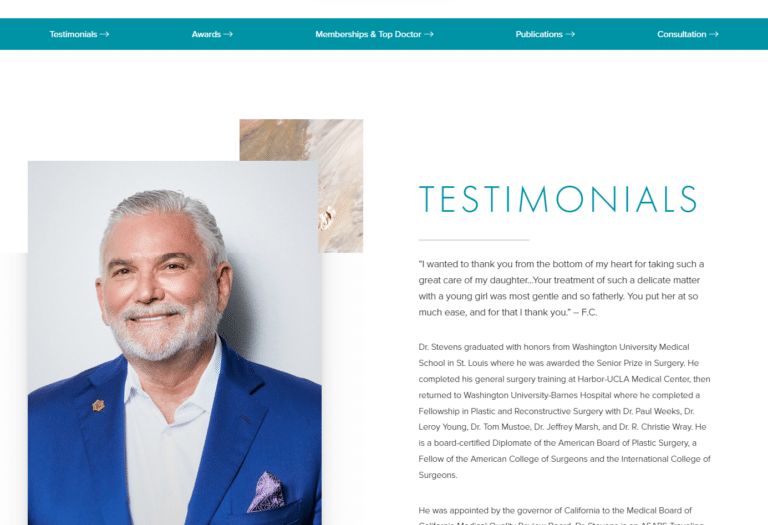The foundation of any successful healthcare practice has always been trust. Today, this trust is not only cultivated in the confines of examination rooms but also built and nurtured online, where a significant portion of patient engagement now begins. For medical professionals, understanding and implementing strategies to enhance trust through their digital presence is not just beneficial for the doctor-patient relationship, it’s also essential for improving visibility in Google searches.

What Are Google’s E-E-A-T Guidelines?
In the complex web of online information, the credibility and quality of content are paramount, especially when it comes to health-related information. Google’s E-E-A-T guidelines — Experience, Expertise, Authoritativeness, and Trustworthiness — offer a framework for the search engine giant to evaluate content, with a particular emphasis on pages that can impact a person’s health, financial stability, or safety, known as “Your Money or Your Life” (YMYL) pages. For medical professionals and healthcare providers, understanding and applying these guidelines is crucial in establishing a trustworthy online presence.
Let’s break down these guidelines a little further:
Experience
Experience refers to the practical knowledge or proficiency a content creator has in the specific topic they are discussing. This means medical website content should be created or reviewed by professionals with direct experience in the healthcare field. Sharing personal experiences, case studies, or patient stories (with consent) can add a layer of relatability and trust that purely theoretical knowledge cannot.
Expertise
Expertise is about formal qualifications, certifications, and educational background that validate an individual’s command over a subject. In the medical field, showcasing the credentials, degrees, and professional training of the healthcare providers not only boosts the website’s credibility but also reassures visitors of the reliability of the information presented. It’s about proving that the advice or information comes from individuals who are qualified to provide it.
Authoritativeness
Authoritativeness is the recognition of a website or content creator as a reputable source in their field. For medical websites, this can be achieved through endorsements from reputable medical associations, publications in peer-reviewed medical journals, and citations from authoritative healthcare sites. It can also include notable speaking engagements, media mentions and news appearances. Building a reputation takes time and consistent effort in producing high-quality, accurate, and up-to-date information.
Trustworthiness
Trustworthiness, perhaps the most critical element for medical websites, revolves around the integrity and honesty of the site and its content. It encompasses ensuring the privacy and security of patient information, transparency about the authorship of content, and the presence of clear, accurate, and helpful health information. Trust is also built by avoiding misleading information or promises about health outcomes, which can harm the site’s credibility and, more importantly, patient well-being.
The Significance of E-E-A-T in Healthcare
In the healthcare industry, where the accuracy of information can directly impact patient health and decision-making, E-E-A-T is not just a guideline but a responsibility. Google prioritizes high E-E-A-T signals for YMYL content, directly affecting how such content ranks in search results. Thus, for medical professionals, adherence to these principles is not only ethical but practical, enhancing visibility and accessibility to those in search of reliable health information.
Moreover, in a digital age marked by misinformation and health-related scams, strong E-E-A-T signals serves as a badge of honor, distinguishing legitimate medical professionals and trustworthy health advice from the sea of unreliable sources. It reassures patients and website visitors that the information they are consuming is not just accurate, but also safe and reliable, fostering a digital environment where trust in healthcare professionals can thrive.
Strategies for Demonstrating Trustworthiness on Your Website
For healthcare professionals, building trustworthiness online reflects the integrity of the medical practice and ensures that patients feel secure and informed in their health-related decisions. Here are key strategies to enhance the trustworthiness of your medical website, aligned with Google’s E-E-A-T guidelines:
Showcasing Credentials and Experience
- Highlight Qualifications: Clearly display the credentials, certifications, and professional experience of healthcare providers. Include detailed bios that speak to their expertise in specific medical fields.
- Professional Affiliations: Mention memberships in reputable medical associations and societies to underscore professional credibility and adherence to industry standards.
Creating High-Quality, Patient-Centric Content
- Informative and Accurate Information: Publish well-researched and accurate content that addresses common patient concerns and questions. Ensure all medical advice is backed by scientific research and consensus in the medical community.
- Patient Education: Offer comprehensive guides, articles, and FAQs that educate patients about conditions, treatments, and health maintenance, empowering them to make informed decisions.
Securing Your Website
- HTTPS Protocol: Use HTTPS to secure your website, protecting patient data and ensuring safe browsing. This is a fundamental element of trustworthiness for any website, especially medical ones handling sensitive information.
- Privacy Policies and Data Protection: Clearly articulate privacy policies and data protection measures. Be transparent about how patient data is collected, used, and protected.
Patient Testimonials and Reviews
- Authentic Testimonials: Share genuine patient testimonials (with consent) to provide real-life examples of the care and outcomes patients can expect.
- Manage Online Reviews: Actively monitor and respond to reviews on third-party sites. Positive engagement demonstrates openness to feedback and commitment to patient satisfaction. Always adhere to HIPAA standards regarding protected health information.
Regular Updates and Active Engagement
- Content Freshness: Regularly update your website with the latest health information, news, and clinic updates to keep content relevant and demonstrate active involvement in patient care.
- Interactive Features: Implement Q&A sections, blogs, or forums where patients can engage directly with healthcare providers. This not only enriches the website content but also builds a community around your practice.
Technical and Ethical Considerations
- Mobile Optimization: Ensure your website is mobile-friendly, providing a seamless experience for users on any device. This accessibility is a critical component of trustworthiness in today’s mobile-first world.
- Ethical Advertising: Be cautious with advertising and promotions. Ensure that any sponsored content or advertisements are clearly labeled and do not compromise the impartiality of your medical advice.
By implementing these strategies, healthcare professionals can significantly enhance the trustworthiness of their online presence. It’s about creating a digital environment where patients feel informed, valued, and secure. This trust is not built overnight but is a result of consistent effort in providing high-quality, reliable, and patient-centered content and services.
Expanding Trust Beyond Your Website
While a trustworthy website is foundational, establishing trust with patients online requires a holistic approach that extends beyond your website. Here are strategies for healthcare professionals to build and maintain trust across the web:
Social Media Presence
- Engage Regularly: Use social media platforms to share health tips, news, and updates about your practice. Regular engagement helps build a community and fosters a personal connection with patients.
- Responsive Interaction: Respond to comments, messages, and questions promptly. This interaction demonstrates your commitment to patient care and accessibility.
- Educational Content: Share informative content that adds value to your followers’ lives. This could include health awareness posts, preventive care tips, and insights into common health conditions, all aimed at educating and empowering your audience.
Online Reputation Management
- Monitor Your Online Presence: Keep an eye on what is being said about your practice across various platforms, including review sites like Google My Business and Healthgrades. Online reputation management tools can automate this process and alert you to new mentions or reviews. Not sure how your online reputation looks? Get your free scorecard here!
- Address Negative Feedback: Respond to negative reviews professionally and constructively. Offering to take the conversation offline to resolve issues can demonstrate your willingness to listen and improve.
- Encourage Positive Reviews: Encourage satisfied patients to share their experiences online. Positive reviews can significantly boost your practice’s reputation and help prospective patients feel more confident in choosing your services.

Collaborations and Guest Posts
- Partner with Other Experts: Collaborate with other healthcare professionals or influencers in the health and wellness space. This can include joint webinars, podcasts, or live Q&A sessions that showcase your expertise and reach a wider audience.
- Contribute to Reputable Publications: Writing guest posts for well-known health blogs or medical journals can enhance your credibility and authority in your field. It provides exposure to a broader audience and establishes you as a thought leader.
Community Involvement and Outreach
- Participate in Community Health Events: Engaging with your local community through health fairs, seminars, or free clinics can build trust and raise awareness of your practice.
- Offer Expert Advice: Volunteer to provide expert commentary on health segments for local news outlets or write informative pieces for local newspapers. This visibility can bolster your reputation as a trusted healthcare provider in your community.
Leverage Professional Networks
- Join Professional Associations: Being active in professional organizations not only keeps you abreast of industry developments but also connects you with peers and potential patients.
- Networking Events: Attend or speak at medical conferences and networking events. These platforms can be invaluable for building professional relationships and enhancing your practice’s visibility.
Building trust beyond your website involves a consistent and multi-faceted approach. By engaging with patients and the broader community across various platforms, you can reinforce your commitment to trustworthy and patient-centered care. This holistic approach not only enhances your online reputation but also strengthens the overall trust in your healthcare practice.
Measuring Success and Adjusting Strategies
Establishing trust and credibility online is only part of the process. It’s equally important to measure the effectiveness of these efforts. By tracking specific metrics and adjusting your strategies based on data, you can ensure your online presence is effectively building trust with your audience. Here’s how to measure success and fine-tune your approach:
Key Metrics to Monitor
- Website Traffic: Use tools like Google Analytics to monitor overall traffic, page views, and the source of your visitors. An increase in traffic, especially to key pages like your bio, services, and patient resources, can indicate growing trust and interest.
- Engagement Rates: On social media and your website, track likes, shares, comments, and time spent on pages. High engagement rates suggest that your content resonates with your audience and fosters a sense of community.
- Conversion Rates: For healthcare websites, conversions might include booking appointments, signing up for newsletters, or downloading patient resources. Improvements in these areas can signal trust and a willingness to engage further with your practice.
- Bounce Rate: A high bounce rate (visitors leaving your site quickly after arriving) might indicate that your site’s content or user experience is not meeting visitors’ expectations. Lower bounce rates can suggest that your site is valuable and trustworthy to visitors.
- Patient Reviews and Feedback: Quantitative (star ratings) and qualitative (written reviews) feedback on review sites and your own website provide direct insight into patient satisfaction and trust.

Adjusting Your Strategies
- Content Relevance and Quality: If engagement is low, review your content strategy. Is your content relevant, up-to-date, and patient-centered? Adjusting topics or formats (e.g., incorporating more video content) might improve engagement.
- Website User Experience (UX): High bounce rates could indicate UX issues. Ensure your site is easy to navigate, mobile-friendly, and fast-loading. Small improvements can make a big difference in keeping visitors engaged.
- Social Media Approach: If social media engagement is lacking, experiment with different types of posts, posting times, and interactive content like polls or live Q&As. Tailoring your approach to your audience’s preferences can increase interaction.
- Review Management: Negative feedback should be addressed promptly and constructively. If certain issues are recurrent, consider how internal practices might be adjusted to address patient concerns.
Soliciting Patient Feedback
- Surveys and Questionnaires: Regularly solicit feedback from your patients through surveys or questionnaires. This direct feedback can provide actionable insights into how your online presence affects patient trust and satisfaction.
- Patient Advisory Boards: Consider establishing a patient advisory board to gain deeper insights into patient needs and perceptions. This can guide more targeted adjustments to your online strategy.
Continuous Improvement
Building trust online is an ongoing process. The digital landscape and patient expectations evolve, so regularly reviewing your metrics and being willing to adjust your strategies is crucial. Set aside time regularly to review your performance, celebrate successes, and identify areas for improvement. By staying adaptable and patient-focused, you can ensure your online presence continuously aligns with the needs and expectations of your audience, fostering a lasting sense of trust and credibility.
Ready to Elevate Your Online Presence? Take the Next Step Today
In the journey toward building a trustworthy and engaging online presence, the path is ongoing and ever-evolving. Whether you’re starting from scratch or looking to enhance your current strategies, the importance of aligning with Google’s E-E-A-T guidelines and extending your trust-building efforts beyond your website cannot be overstated. But you don’t have to navigate this path alone.
Thunderhead Marketing is here to guide you every step of the way. Our expertise in digital marketing for healthcare professionals can help you craft an online presence that not only meets but exceeds the expectations of your patients. From optimizing your website for trust and credibility to expanding your influence across the web, we’re ready to help you make a meaningful impact.
Don’t let the potential of your online presence go untapped. Contact Thunderhead Marketing for a personalized consultation. Let’s work together to build an online presence that reflects the high quality of care you provide. Reach out now to start your journey towards a more trusted and engaging digital footprint.







